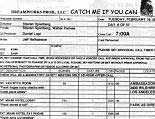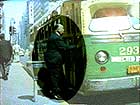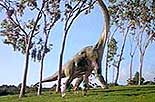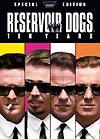
|







(alphabetical and illustrated) Introduction | A - 1 | A - 2 | B - 1 | B - 2 | C - 1 | C - 2 | C - 3 | D | E | F G - H | I - J - K | L - M | N - O | P | Q - R | S - 1 | S - 2 | T | U - V - W - X - Y - Z |
|
|
|
|
| a type of schedule given out periodically during a film's production to let every department know when they are supposed to arrive and where they are to report; usually refers to a listing of actors necessary for scenes |  Example:
the call sheet from Spielberg's Catch Me If You Can (2002) Example:
the call sheet from Spielberg's Catch Me If You Can (2002) |
|
| originally meaning "a small piece of artwork," refers to a bit part (usually a brief, non-speaking or walk-on role that is uncredited or unbilled) or special screen appearance by a famous actor, director, or prominent person who would ordinarily not take such a small part; contrast to a bit part; also refers to a type of camera shot in which the subject is filmed against a black or neutral background. See Directors' Cameos. |  Examples: Alfred
Hitchcock's witty, trademark cameos in his own films such as
in North by Northwest (1959); and
the many cameos in Robert Altman's The Player (1992), and
in Austin Powers in Goldmember
(2002); other directors with cameos (Roman Polanski, Francis
Ford Coppola, Martin Scorsese, Walter Huston); also other examples
include Ted Knight in Psycho (1960),
and Sylvester Stallone in Bananas (1971) Examples: Alfred
Hitchcock's witty, trademark cameos in his own films such as
in North by Northwest (1959); and
the many cameos in Robert Altman's The Player (1992), and
in Austin Powers in Goldmember
(2002); other directors with cameos (Roman Polanski, Francis
Ford Coppola, Martin Scorsese, Walter Huston); also other examples
include Ted Knight in Psycho (1960),
and Sylvester Stallone in Bananas (1971) |
|
| the basic machine involved in film-making, from a hand-held version to portables, to heavy studio cameras; some of the parts of a camera include the aperture, lens, film magazine (for storage), viewfinder, etc; the positioning of the camera by the camera operator is known as the setup |  Example: a film camera |
|
| the point of view (POV) or perspective (including relative height or direction) chosen from which to photograph a subject. Various camera angles, compositions, or positions include: front, behind, side, top, high (looking down), low (looking up), straight-on or eye-level (standard or neutral angle), tilted (canted or oblique), or subjective, etc.; see also framing |  Example: Extreme camera angles can be found in The Third Man (1949). |
|
| the use of the camera to obtain various camera angles and perspectives. (See motion picture camera shots below, including the pan, tilt, track, and zoom; also boom/crane shots, Steadicam, or hand-held) | ||
| the individual who is responsible for operating the camera, under the direction of the film's director and director of photography (or cinematography) | ||
(or campy) |
a type of comedy parody wherein conventional (and especially overused or clichéd) situations and plot devices are intentionally exaggerated to the point of absurdity to produce humor |  Examples: The Rocky Horror Picture Show (1975) and Barbarella (1968). |
("in the can") |
refers to the round metal/plastic container that holds or stores film (reels) for transport or for long-term storage; a film that has been completed is known colloquially as "in the can"; canned means pre-recorded; also see reel |  A film can (or canister) with reel of film inside |
| refers to lighting that is provided by candlelight, to provide a warm hue or tone, and connote intimacy, romance, and harmony |  Example:
Stanley Kubrick's period costume drama Barry Lyndon (1975) was
largely filmed with natural light and candlelight Example:
Stanley Kubrick's period costume drama Barry Lyndon (1975) was
largely filmed with natural light and candlelight |
|
| a short movie review | ||
| the descriptive, printed line(s) of text that occasionally appears on the screen, usually at the bottom of the frame, to describe the time/place, or to translate a foreign word/phrase; different from closed-captioning (closed captions are all white uppercase (capital) letters encased in a black box that require a decoder or television with a decoder chip to be viewed) for deaf or hard-of-hearing viewers; see also subtitles |  Example: a caption from a foreign film, Kieslowski's Decalogue (1988) |
|
| a character appearing ridiculously out of proportion because of one physical, psychological or moral trait that has been grossly or broadly exaggerated; a caricature often portrays a character in an unrealistic, stereotypical fashion |  A cartoon caricature of Groucho Marx. |
|
| an animated film that is usually not of feature length; also see animation |  A poster from a Mickey Mouse animated cartoon Barn Dance (1928). |
|
| in movie terms, a definitely guaranteed,
'can't-miss' blockbuster film that promises to generate disproportionately
tremendous profits due to its lucrative franchise (sequels,
merchandising, spin-offs, etc.). See Greatest
Film Franchises of All-Time. |
Examples: the Star Wars franchise, the Indiana Jones films, the Spider-Man films, etc. | |
| a collective term for all of the actors/performers (or talent) appearing in a particular film: usually broken down into two parts: the leads with speaking roles, and the seconds or supporting characters, background players or extras, and bit players |  Example:
typical end credits (for the major cast members) from
an older film. Example:
typical end credits (for the major cast members) from
an older film. |
|
| an actor playing a role distinctly different from roles previously played |  Humphrey
Bogart, as good-guy Rick Blaine, was an example of casting against type
- to give him a brand new image to portray. Bogart had played gangster
figures in dozens in films before Casablanca (1942);
also good-guy Henry Fonda as evil, blue-eyed Frank in Once Upon a
Time in the West (1968, It.) Humphrey
Bogart, as good-guy Rick Blaine, was an example of casting against type
- to give him a brand new image to portray. Bogart had played gangster
figures in dozens in films before Casablanca (1942);
also good-guy Henry Fonda as evil, blue-eyed Frank in Once Upon a
Time in the West (1968, It.) |
|
| the process of selecting and hiring actors to play the roles and characters in a film production, and be brought under contract; the lead roles are typically cast or selected by the director or a producer, and the minor or supporting roles and bit parts by a casting director; type-casting refers to an actor playing only roles similar to those he/she has played before |  A
classic example of typecasting was Clark Gable as Rhett Butler in Gone
With the Wind (1939), by producer David O. Selznick and by popular
choice. In addition, John Wayne was often typecast as a western cowboy,
Errol Flynn as a swashbuckler, Cary Grant as a debonair gentleman/lover,
and Arnold Schwarzenegger as an indomitable strong-guy or 'terminator'. A
classic example of typecasting was Clark Gable as Rhett Butler in Gone
With the Wind (1939), by producer David O. Selznick and by popular
choice. In addition, John Wayne was often typecast as a western cowboy,
Errol Flynn as a swashbuckler, Cary Grant as a debonair gentleman/lover,
and Arnold Schwarzenegger as an indomitable strong-guy or 'terminator'. |
|
| refers to the illegal practice (mostly during the heyday of the studio system) when unknown young actors or actresses (starlets) exchanged sex (literally on an office couch) with a casting director or producer in order to acquire/land a role in a film | Example: Frances McDormand, who played the role of Marge Gunderson in Fargo (1996), once joked that she got the role by the 'casting couch' method - she 'slept with' the director Joel Coen - her husband! | |
| an advertising claim, often used in big-screen historical epics of the 1930s-60s, when literally 1,000s of extras were hired for crowd scenes, battle scenes, etc |  Examples: Spartacus
(1960) (pictured), Cleopatra (1963). To reduce costs, recent
films use CGI to create fictional crowds, such as in Gladiator (2000). Examples: Spartacus
(1960) (pictured), Cleopatra (1963). To reduce costs, recent
films use CGI to create fictional crowds, such as in Gladiator (2000). |
|
| short phrases, expressions, or words that have become favored and/or popularized due to repeated use, often by film critics | Examples: "over the top", "indie-style", "laugh riot", "frightfest", "crowd-pleaser", "Oscar-worthy", "three-hankie ending", "haunting images", "urban comedy", "beautifully realized", etc. | |
| during a film's climax, the audience may experience a purging or cleansing of emotional tension, providing relief or therapeutic restoration | ||
| A literary term, referring to a narrative
with a moral message warning of the consequences of certain actions,
ideologies, character flaws, technologies or institutions, often with
a downbeat ending; many slasher horror films are semi-cautionary
tales about one of the consequences of sex or experimenting with the
occult --- death; see also satire, morality tale and nihilism |
Example: Reefer Madness (1936); Dr. Strangelove, Or:... (1964); Planet of the Apes (1968); WarGames (1983); the segment about Mr. Creosote and his gluttonous appetite in Monty Python's The Meaning of Life (1983); The Evil Dead series; Gremlins (1984); thirteen (2002). | |
(or celluloid, animation cel) |
refers to each of the thousands of hand-drawn sheets (of clear, transparent material, either celluloid or Mylar) representing a single animation frame to allow several layers of composition. Cels consist of character cels (containing only the foreground characters or objects - those things that move from frame to frame) and background cels, (static drawings of scenery that remain the same). The character cels are placed against the background cels and filmed or shot one frame (or picture) at a time to produce the effect of motion. Celluloid also refers to the thin strip of transparent plastic coating that forms the film's highly-flammable, light-sensitive base layer (such as nitrate base or acetate base); also used as an adjective related to some aspect of cinema (e.g., "the celluloid hero"); the light-sensitive substance coating on one side of the film base is termed emulsion; celluloid is also a slang word for a movie |  Example:
A production cel of Dumbo and Timothy the Mouse from Dumbo (1941). Example:
A production cel of Dumbo and Timothy the Mouse from Dumbo (1941). |
|
|
the process of determining what can or can not be viewed by the public or depicted by the motion picture industry; also refers to changes required of a movie by some person or body (other than the studios or film-makers, such as a national or regional film classification board); see also rating systems and banned. See Sex in Cinema and Most Controversial Films of All-Time. |
|
|
|
aka Computer-Generated Imagery (or Images), a term referring to the use of 3D computer graphics and technology (digital computers and specialized software) in film-making to create filmed images, special effects and the illusion of motion; often used for large crowd scenes to cut down on the cost of hiring extras, or for giant creatures, huge buildings, and other costly items. See Visual/Special Effects. |
 Example:
Jurassic Park (1993) and its giant dinosaurs, or used in large crowd scenes in Gladiator (2000) or in the prologue battle scene in The Lord of the Rings: The Fellowship of the Ring (2001) Example:
Jurassic Park (1993) and its giant dinosaurs, or used in large crowd scenes in Gladiator (2000) or in the prologue battle scene in The Lord of the Rings: The Fellowship of the Ring (2001) |
|
|
the small dot, oval or mark on the top-right corner of a film frame that signaled to the projectionist to change over from one projector (or film reel) to another (about every 15-20 minutes); nowadays, most film theatres have only one projector - the reels are spliced together into one giant roll and fed into a single projector from a horizontal revolving turntable called a platter |  Example:
the change-over cue during the Broadway Melody musical number in
Singin' in the Rain (1952) Example:
the change-over cue during the Broadway Melody musical number in
Singin' in the Rain (1952) |
|
|
the fictitious or real individual in a story, performed by an actor; also called players. | |
|
|
an actor who specializes in playing well-defined, stereotypical, archetypal, off-beat, humorous, or highly-recognizable, fictional roles of a particular physical, emotional, or behavioral type, in a supporting role; see also typecasting. | Examples: Hattie McDaniel as a black maid, such as in Alice Adams (1935) and Gone With the Wind (1939), or Walter Brennan as a Western sidekick, such as in Red River (1948). |
|
|
refers to identifying a film's character or persona with a particular color; changes in color often represent transformations, shifts, merges, or changes in persona |  Examples:
the explicit naming of the characters by color in Quentin Tarantino's Reservoir Dogs (1992); also the color-coded couples in Kenneth Branagh's Love's
Labour's Lost (2000) Examples:
the explicit naming of the characters by color in Quentin Tarantino's Reservoir Dogs (1992); also the color-coded couples in Kenneth Branagh's Love's
Labour's Lost (2000) |
|
|
a film that
uses strong characterizations, interactions and the personalities of its
characters to tell a story, with plot and narrative almost secondary to
them |
Examples: The Seven Samurai (1954), Atlantic City (1981), The Grifters (1990), Dead Man Walking (1995). |